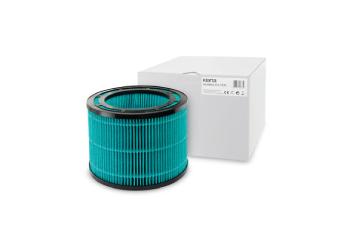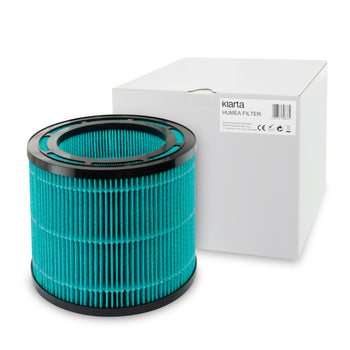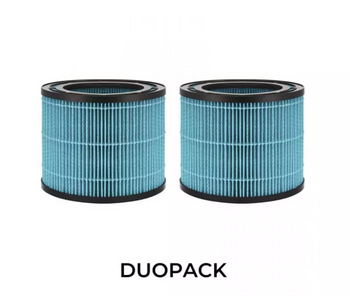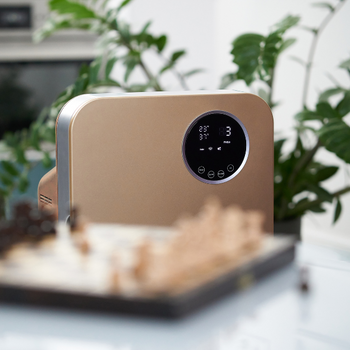
Air Purifier Against Smog: Clean Air in 215 ft² in 5 minutes - Klarta
Clean air in 215 ft² in 5 minutes, 430 ft² in 10 minutes, or 645 ft² in 15 minutes?
The Klarta Stor proves that this is possible. We have created an air purifier that takes the issue of breathing harmful air very seriously, knowing that every µg of suspended particles, tobacco smoke, or irritating allergens brings users closer to developing more or less irreversible health issues.
Why is purification time so important? What are the benefits of breathing clean air?

Rapid response of Klarta air purifiers to smog – why is purification time crucial?
Being in a polluted environment has serious health consequences. Every minute, micro-particles of suspended dust enter our lungs, which can lead to upper and lower respiratory tract infections.
In the long term, these particles can exacerbate allergy or asthma symptoms. They increase the risk of developing atherosclerosis, coronary artery disease, heart attacks, and strokes.
Similarly, tobacco smoke that remains un-purified settles on walls, furniture, and clothing, eventually entering our respiratory system.

While short, single exposures should not have any negative health effects, regular exposure to dirty air can affect both respiratory and cardiovascular systems.
This is confirmed by studies involving mice published in 2018, which analyzed the impact of traditional smog (so-called London smog) and photochemical smog (involving ozone) on the cardiovascular and respiratory systems of these animals.
Single exposures to air with exceeded levels of suspended particles did not pose any threat. However, longer exposures could lead to heart arrhythmias.
Ozone (photochemical smog) proved to be somewhat more dangerous, where even a short episode caused a reduction in the animals' pulse along with an increase in the heart rate variability coefficient.

Precise sensors + restrictive automatic modes = Uncompromising approach to smog and allergens
An impressive CADR reaching 600 m³/h, versatile large-area filters supported by air ionization, and intelligent operation of three Auto modes make the Klarta Stor air purifier leave no chance for air pollutants.
Our device needs just 5 minutes to significantly reduce pollution levels in a 215 ft² room.
Purifying open spaces of 860 ft² in 20 minutes is a preferred choice for institutions and public facilities, such as schools and kindergartens.
The algorithm for air quality assessment and the uncompromising automatic mode, developed and refined over the years by our engineers, are also present in the compact air purifier for smaller rooms – Klarta Forste.
Being an ideal option for bedrooms or children's rooms, the Forste is also equipped with three automatic modes and eight speed levels, allowing smooth, balanced operation with the highest concern for users' health.
Can an air purifier be on 24/7? The importance of auto mode in purifiers
Not only the exposure time of household members to pollutants is important, but also the duration for which the purifier remains on.
If possible, we recommend leaving the air purifier on Auto mode (e.g., Auto Sleep) for 24 hours a day. It is not possible to "store" clean air.
That’s why we have introduced the 3 x Auto Mode function in the latest generation of Klarta air purifiers. The three automatic modes allow the purifier to operate autonomously, considering not only the ambient conditions but also the needs and acoustic comfort of our customers.
 The superiority of automatic mode is also confirmed by a 2023 study by Chinese scientists. They compared the efficiency of air purifiers working according to timer settings with those operating based on PM2.5 sensor readings.
The superiority of automatic mode is also confirmed by a 2023 study by Chinese scientists. They compared the efficiency of air purifiers working according to timer settings with those operating based on PM2.5 sensor readings.
Purifiers filtering air by timer achieved an average air quality improvement of 29.2%. Meanwhile, the time users spent in polluted air was reduced by 13.4%.
In comparison, purifiers that remained on and worked based on PM2.5 sensor readings reduced the level of suspended particles by 47.6%.
The time spent in polluted air was reduced by 23.1%. This difference clearly shows not only the sense of having an air purifier but also using it not just "occasionally."
Devices created by our engineers combine intelligent operation with quiet and energy-efficient performance.

Give yourself and your loved ones clean air
Check out our current promotions on Klarta air purifiers and give your loved ones a sense of security and care.
An air purifier can be an excellent gift idea for both the elderly and new parents. The device protects against:
- Coughing, runny nose, and throat and nose irritation
- Upper and lower respiratory tract infections
- Exacerbation of allergy and asthma symptoms
- Cardiovascular diseases
- Strokes
- Respiratory and urinary system cancers
- Neurodegenerative diseases and memory and concentration problems
- Lower muscle mass in newborns
FAQ – Frequently Asked Questions
Does a H13 filter capture smog?
We have equipped Klarta air purifiers with large-surface H13 filters. They can capture up to 99.97% of the most dangerous fraction of suspended particles – PM2.5.
The large surface area of the filters translates into purification efficiency and the longevity of the filtering materials.
How long should an air purifier run?
Even the best air purifier cannot provide clean air in a room if it is turned off.Given the continuous inflow of air masses to the area, it is not possible to "store" clean air.
Can you open windows with an air purifier?
Of course, you can. However, it is not advisable to keep the window open for too long, allowing polluted air masses from outside to enter the room.
Short, intense intervals of ventilation are indeed necessary.
Sources:
1. Hazari, Mehdi S et al. “Comparative Cardiopulmonary Effects of Particulate Matter- And Ozone-Enhanced Smog Atmospheres in Mice.” Environmental science & technology vol. 52,5 (2018): 3071-3080. doi:10.1021/acs.est.7b04880.2. https://doi.org/10.1016/j.partic.2022.11.008











